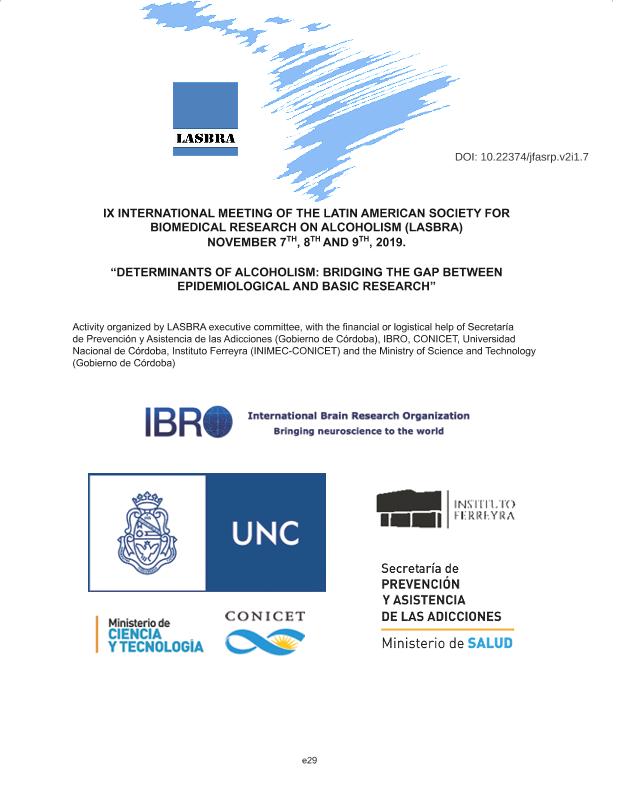Mostrar el registro sencillo del ítem
dc.contributor.author
Anunziata, Florencia

dc.contributor.author
Macchione, Ana Fabiola

dc.contributor.author
Angulo Alcalde, Asier
dc.contributor.author
Trujillo, María Verónica
dc.contributor.author
Wille-bille, Aranza

dc.contributor.author
Amigone, José Luis
dc.contributor.author
Molina, Juan Carlos

dc.date.available
2022-11-16T18:17:45Z
dc.date.issued
2019
dc.identifier.citation
Sensitization to ethanol’s disruptive effects upon early breathing plasticity associated with hypoxia and hypercapnia; IX LASBRA International Meeting: Determinants of Alcoholism: bridging the gap between epidemiologic and basic research; Córdoba; Argentina; 2019; 56-56
dc.identifier.uri
http://hdl.handle.net/11336/178052
dc.description.abstract
Ethanol (EtOH) consumption during pregnancy and lactation represents a risk factor related with the Sudden Infant Death Syndrome (SIDS). This phenomenon has promoted research linking prenatal EtOH effects on the respiratory system during early ontogeny. It should also be noted that prolonged episodes of neonatal respiratory depression represent a risk factor in terms of hypoxic-ischemic effects with negative consequences on brain development. In a first study during postnatal day (PD) 9 we analyzed the impact of different doses of EtOH (0.0, 0.75, 1.37 or 2.0 g/kg) upon the respiratory response and the potential psychomotor effects in pup rats pre-exposed or not to 2.0 g/kg of EtOH during PDs 3-7. At PD 9 animals were also subjected to sequential air conditions defined as initial normoxia, hypoxia and recovery normoxia. In a second study we analyzed the blood of animals only exposed to 0.0 or 2.0g/kg of EtOH during PDs 3-9 (not subjected to a hypoxic event). The aim was to examine if mere intoxication with a moderate dose of EtOH is capable of modifying blood metabolic patterns associated with hypoxia or hypercapnia. In the first study during PDs 3-7 EtOH exerted a depressant effect upon breathing frequencies. These animals also showed a progressive sensitization effect relative to the depressant effects of the drug and lesser levels of apneas. At PD 9 dose dependent respiratory depressions were observed when pups were challenged with a hypoxic event. Independently from prior experience with EtOH, drug treatment at PD 9 significantly disrupted respiratory frequencies particularly during the hypoxic and the recovery normoxia phases. Respiratory disorders triggered by these air conditions have been implicated in the pathophysiology of SIDS. These results show that breathing plasticity is disrupted during a critical stage where respiratory alterations may lead to hypoxiaassociated syndromes that endanger brain development. In terms of psychomotor activity, animals exposed to 2.0 g/kg of EtOH at PD 9 showed heightened duration and frequency of grooming. In the second study animals exposed at least one time to EtOH exhibited lower pH and higher CO2 than animals that were never exposed to EtOH. This results suggest metabolic acidosis probably due to EtOH-related hypercapnia during a vulnerable stage in development relative to SIDS.
dc.format
application/pdf
dc.language.iso
eng
dc.publisher
Dougmar Press
dc.rights
info:eu-repo/semantics/openAccess
dc.rights.uri
https://creativecommons.org/licenses/by-nc/2.5/ar/
dc.subject
Ethanol
dc.subject
Hypoxia
dc.subject
Hypercapnia
dc.subject
Hyperventilation
dc.subject
Neonates
dc.subject.classification
Neurociencias

dc.subject.classification
Medicina Básica

dc.subject.classification
CIENCIAS MÉDICAS Y DE LA SALUD

dc.title
Sensitization to ethanol’s disruptive effects upon early breathing plasticity associated with hypoxia and hypercapnia
dc.type
info:eu-repo/semantics/publishedVersion
dc.type
info:eu-repo/semantics/conferenceObject
dc.type
info:ar-repo/semantics/documento de conferencia
dc.date.updated
2022-11-09T17:09:43Z
dc.journal.volume
2
dc.journal.number
1
dc.journal.pagination
56-56
dc.journal.pais
Canadá

dc.journal.ciudad
.Dundas
dc.description.fil
Fil: Anunziata, Florencia. Consejo Nacional de Investigaciones Científicas y Técnicas. Centro Científico Tecnológico Conicet - Córdoba. Instituto de Investigación Médica Mercedes y Martín Ferreyra. Universidad Nacional de Córdoba. Instituto de Investigación Médica Mercedes y Martín Ferreyra; Argentina
dc.description.fil
Fil: Macchione, Ana Fabiola. Consejo Nacional de Investigaciones Científicas y Técnicas. Centro Científico Tecnológico Conicet - Córdoba. Instituto de Investigación Médica Mercedes y Martín Ferreyra. Universidad Nacional de Córdoba. Instituto de Investigación Médica Mercedes y Martín Ferreyra; Argentina. Universidad Nacional de Córdoba. Instituto de Investigaciones Psicológicas. - Consejo Nacional de Investigaciones Científicas y Técnicas. Centro Científico Tecnológico Conicet - Córdoba. Instituto de Investigaciones Psicológicas; Argentina
dc.description.fil
Fil: Angulo Alcalde, Asier. Consejo Nacional de Investigaciones Científicas y Técnicas. Centro Científico Tecnológico Conicet - Córdoba. Instituto de Investigación Médica Mercedes y Martín Ferreyra. Universidad Nacional de Córdoba. Instituto de Investigación Médica Mercedes y Martín Ferreyra; Argentina
dc.description.fil
Fil: Trujillo, María Verónica. Consejo Nacional de Investigaciones Científicas y Técnicas. Centro Científico Tecnológico Conicet - Córdoba. Instituto de Investigación Médica Mercedes y Martín Ferreyra. Universidad Nacional de Córdoba. Instituto de Investigación Médica Mercedes y Martín Ferreyra; Argentina
dc.description.fil
Fil: Wille-bille, Aranza. Consejo Nacional de Investigaciones Científicas y Técnicas. Centro Científico Tecnológico Conicet - Córdoba. Instituto de Investigación Médica Mercedes y Martín Ferreyra. Universidad Nacional de Córdoba. Instituto de Investigación Médica Mercedes y Martín Ferreyra; Argentina
dc.description.fil
Fil: Amigone, José Luis. Hospital Privado de Córdoba. Laboratorio de Bioquímica Clínica; Argentina
dc.description.fil
Fil: Molina, Juan Carlos. Universidad Nacional de Córdoba. Facultad de Psicología; Argentina. Consejo Nacional de Investigaciones Científicas y Técnicas. Centro Científico Tecnológico Conicet - Córdoba. Instituto de Investigación Médica Mercedes y Martín Ferreyra. Universidad Nacional de Córdoba. Instituto de Investigación Médica Mercedes y Martín Ferreyra; Argentina
dc.relation.alternativeid
info:eu-repo/semantics/altIdentifier/url/http://jfasrp.com/index.php/JFASRP/article/view/7
dc.conicet.rol
Autor

dc.conicet.rol
Autor

dc.conicet.rol
Autor

dc.conicet.rol
Autor

dc.conicet.rol
Autor

dc.conicet.rol
Autor

dc.conicet.rol
Autor

dc.coverage
Internacional
dc.type.subtype
Reunión
dc.description.nombreEvento
IX LASBRA International Meeting: Determinants of Alcoholism: bridging the gap between epidemiologic and basic research
dc.date.evento
2019-11-07
dc.description.ciudadEvento
Córdoba
dc.description.paisEvento
Argentina

dc.type.publicacion
Journal
dc.description.institucionOrganizadora
Latin American Society for Biomedical Research on Alcoholism
dc.source.revista
Journal of Fetal Alcohol Spectrum Disorder
dc.date.eventoHasta
2019-11-09
dc.type
Reunión
Archivos asociados
